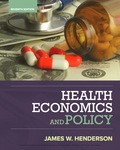CRapter 1s Why Health Economics? 2 Mechanics usually have better information about how to fix automobiles than their customers do. What problems does this advantage create? Do mechanics or their customers do anything to limit these problems? 3 A mandatory health insurance plan costs $4,000. One worker earns $24,500 in employment income and $500 in investment income Another worker earns $48,000 in employment income and $2,00o in investment income. A third worker earns $68,000 in employment income and $7,000 in investment income. A premium-based system would cost each worker $4,000. A wage tax-based system would cost each worker 8.5 percent of wages. An income tax-based system would cost each worker 8 percent of income. For each worker, calculate the cost of the insurance as a share of total income 6) Worker 1Worker 2 Worker 3 $24,500 $48,000$68,000 $500 $2,00o $7,000 $4,000 $4,000 $4,000 = Employment income ef Investment income - Premium cost of insurance Premium as a percentage of income P/(E +ID W = Wage tax cost of insurance-0.085 × E Wage tax cost as a percentage of income W/CE+D 7-income tax cost of insurance-0.080 × (E + 1) Income tax cost as a percentage of incomeTE
CRapter 1s Why Health Economics? 2 Mechanics usually have better information about how to fix automobiles than their customers do. What problems does this advantage create? Do mechanics or their customers do anything to limit these problems? 3 A mandatory health insurance plan costs $4,000. One worker earns $24,500 in employment income and $500 in investment income Another worker earns $48,000 in employment income and $2,00o in investment income. A third worker earns $68,000 in employment income and $7,000 in investment income. A premium-based system would cost each worker $4,000. A wage tax-based system would cost each worker 8.5 percent of wages. An income tax-based system would cost each worker 8 percent of income. For each worker, calculate the cost of the insurance as a share of total income 6) Worker 1Worker 2 Worker 3 $24,500 $48,000$68,000 $500 $2,00o $7,000 $4,000 $4,000 $4,000 = Employment income ef Investment income - Premium cost of insurance Premium as a percentage of income P/(E +ID W = Wage tax cost of insurance-0.085 × E Wage tax cost as a percentage of income W/CE+D 7-income tax cost of insurance-0.080 × (E + 1) Income tax cost as a percentage of incomeTE
Principles of Economics 2e
2nd Edition
ISBN:9781947172364
Author:Steven A. Greenlaw; David Shapiro
Publisher:Steven A. Greenlaw; David Shapiro
Chapter16: Information, Risk, And Insurance
Section: Chapter Questions
Problem 18RQ: What are some of the metrics economists use to measure health outcomes?
Related questions
Question
A mandatory health insurance plan costs $4,000. One worker earns $24,000 in employment income and $500 in investment income. Another worker earns $48,000 in employment income and $2,000 in investment income. A third worker earns $68,000 in employment income and $7,000 in investment income. A premium-based system would cost each worker $4,000. A wage tax-based system would cost each worker 8.5 percent of wages. An income tax-based system would cost each worker 8 percent of income. For each worker, calculate the cost of the insurance as a share of total income.

Transcribed Image Text:CRapter 1s Why Health Economics?
2 Mechanics usually have better information about how to fix
automobiles than their customers do. What problems does this
advantage create? Do mechanics or their customers do anything to
limit these problems?
3 A mandatory health insurance plan costs $4,000. One worker earns
$24,500 in employment income and $500 in investment income
Another worker earns $48,000 in employment income and $2,00o
in investment income. A third worker earns $68,000 in employment
income and $7,000 in investment income. A premium-based system
would cost each worker $4,000. A wage tax-based system would
cost each worker 8.5 percent of wages. An income tax-based system
would cost each worker 8 percent of income. For each worker,
calculate the cost of the insurance as a share of total income
6)
Worker 1Worker 2 Worker 3
$24,500 $48,000$68,000
$500 $2,00o $7,000
$4,000 $4,000 $4,000
= Employment income
ef
Investment income
- Premium cost of insurance
Premium as a percentage of income P/(E +ID
W = Wage tax cost of insurance-0.085 × E
Wage tax cost as a percentage of income W/CE+D
7-income tax cost of insurance-0.080 × (E + 1)
Income tax cost as a percentage of incomeTE
Expert Solution
This question has been solved!
Explore an expertly crafted, step-by-step solution for a thorough understanding of key concepts.
This is a popular solution!
Trending now
This is a popular solution!
Step by step
Solved in 6 steps

Knowledge Booster
Learn more about
Need a deep-dive on the concept behind this application? Look no further. Learn more about this topic, economics and related others by exploring similar questions and additional content below.Recommended textbooks for you

Principles of Economics 2e
Economics
ISBN:
9781947172364
Author:
Steven A. Greenlaw; David Shapiro
Publisher:
OpenStax

Microeconomics: Private and Public Choice (MindTa…
Economics
ISBN:
9781305506893
Author:
James D. Gwartney, Richard L. Stroup, Russell S. Sobel, David A. Macpherson
Publisher:
Cengage Learning

Economics: Private and Public Choice (MindTap Cou…
Economics
ISBN:
9781305506725
Author:
James D. Gwartney, Richard L. Stroup, Russell S. Sobel, David A. Macpherson
Publisher:
Cengage Learning

Principles of Economics 2e
Economics
ISBN:
9781947172364
Author:
Steven A. Greenlaw; David Shapiro
Publisher:
OpenStax

Microeconomics: Private and Public Choice (MindTa…
Economics
ISBN:
9781305506893
Author:
James D. Gwartney, Richard L. Stroup, Russell S. Sobel, David A. Macpherson
Publisher:
Cengage Learning

Economics: Private and Public Choice (MindTap Cou…
Economics
ISBN:
9781305506725
Author:
James D. Gwartney, Richard L. Stroup, Russell S. Sobel, David A. Macpherson
Publisher:
Cengage Learning


Exploring Economics
Economics
ISBN:
9781544336329
Author:
Robert L. Sexton
Publisher:
SAGE Publications, Inc

Principles of Microeconomics
Economics
ISBN:
9781305156050
Author:
N. Gregory Mankiw
Publisher:
Cengage Learning